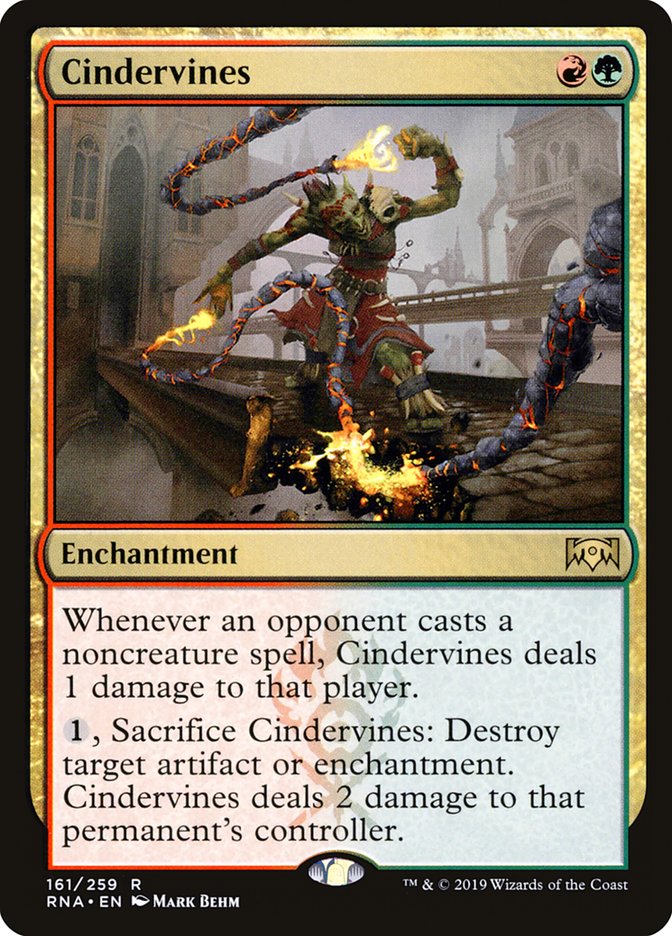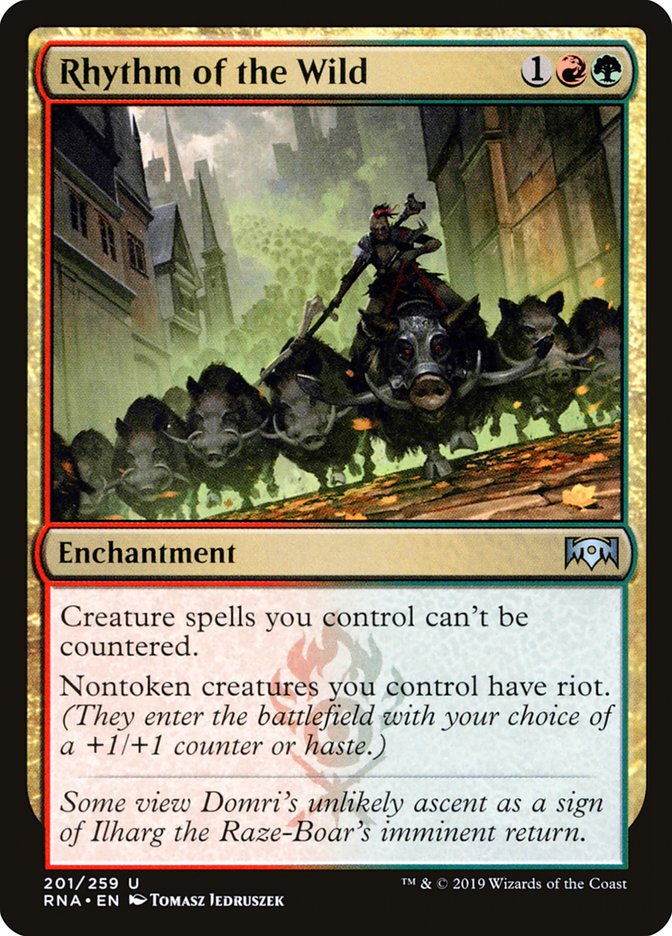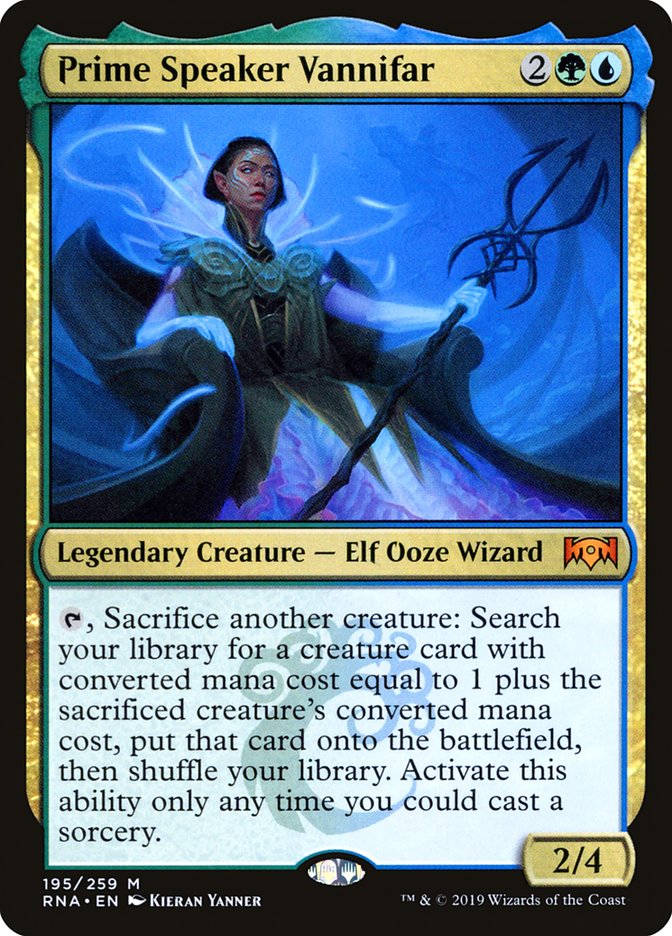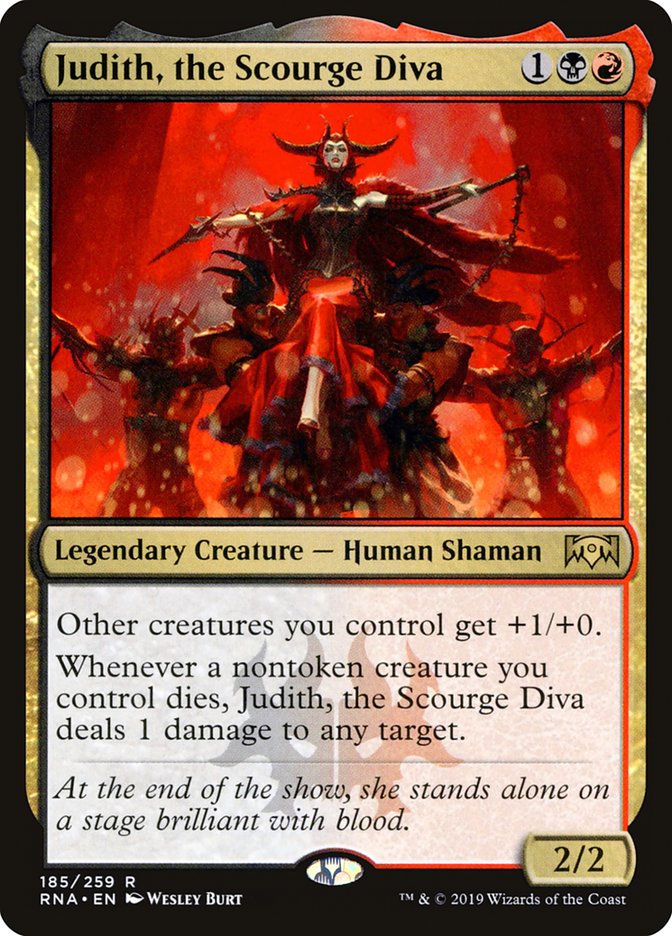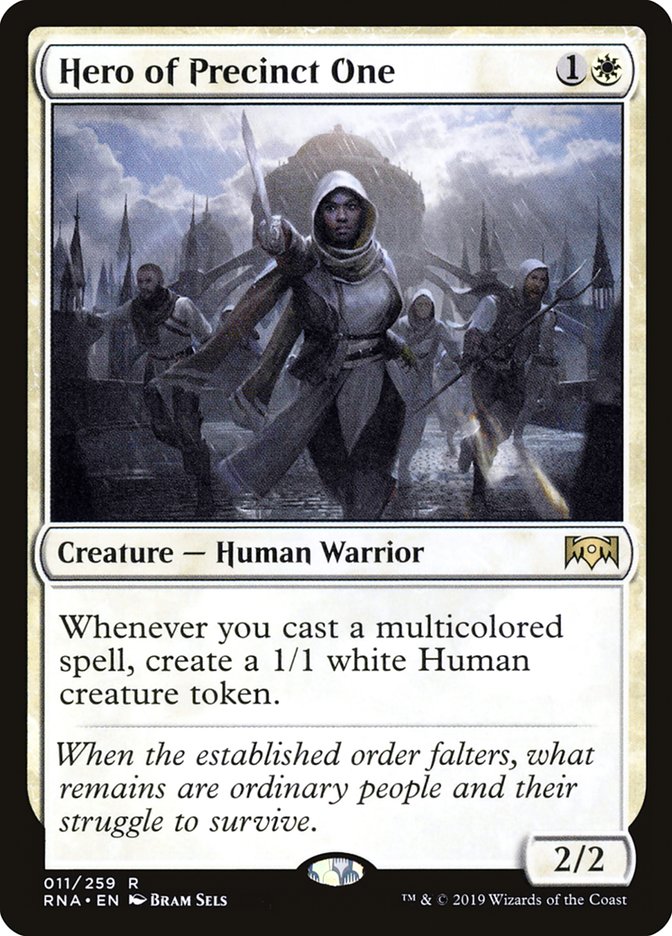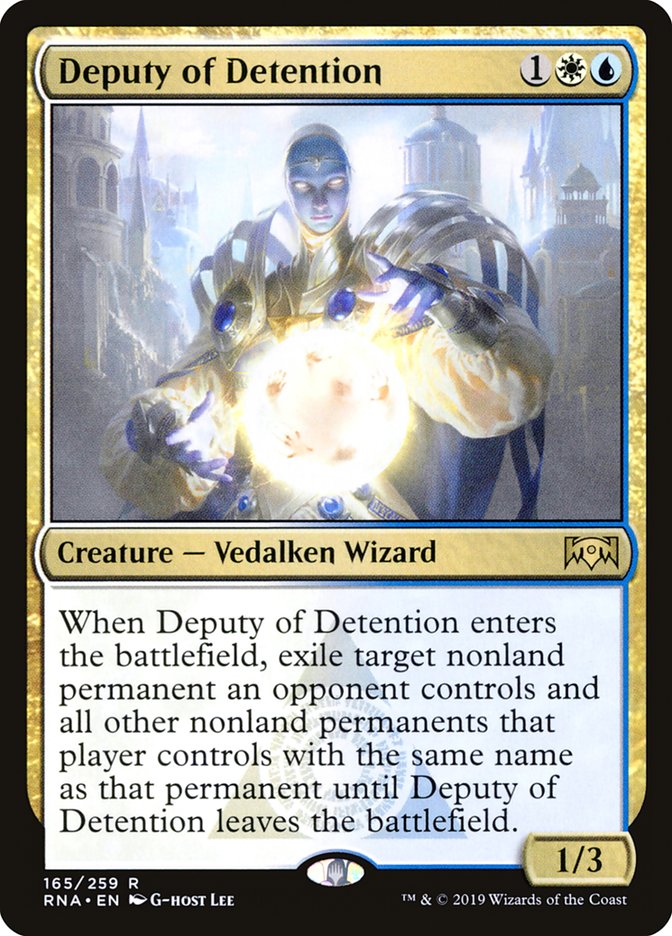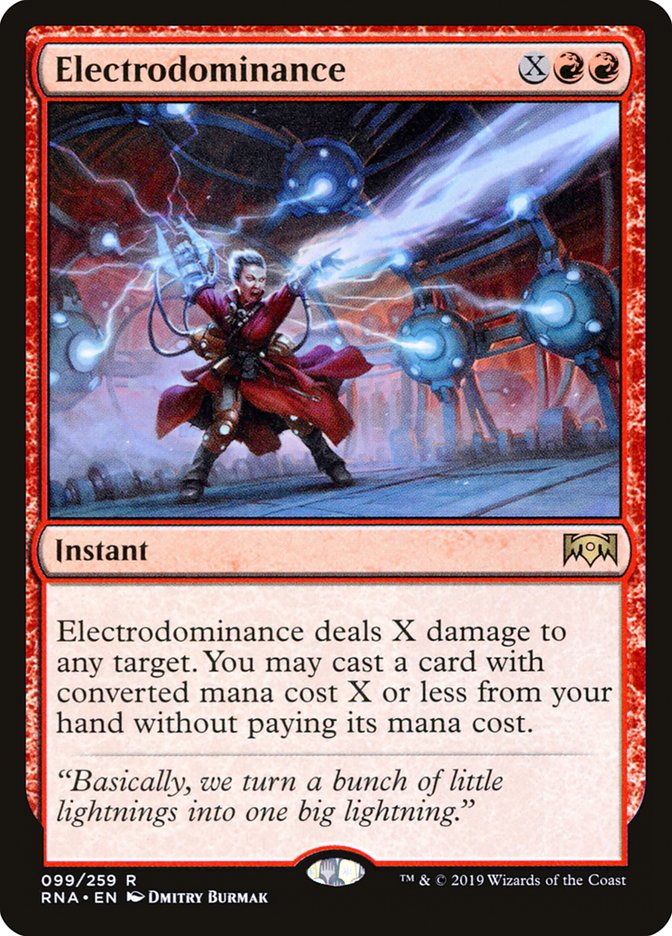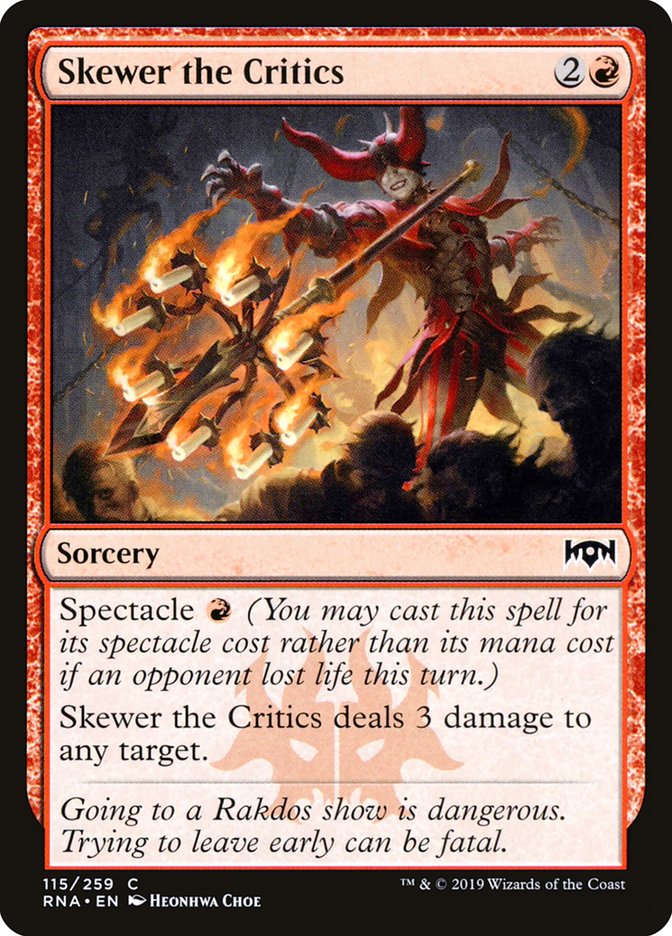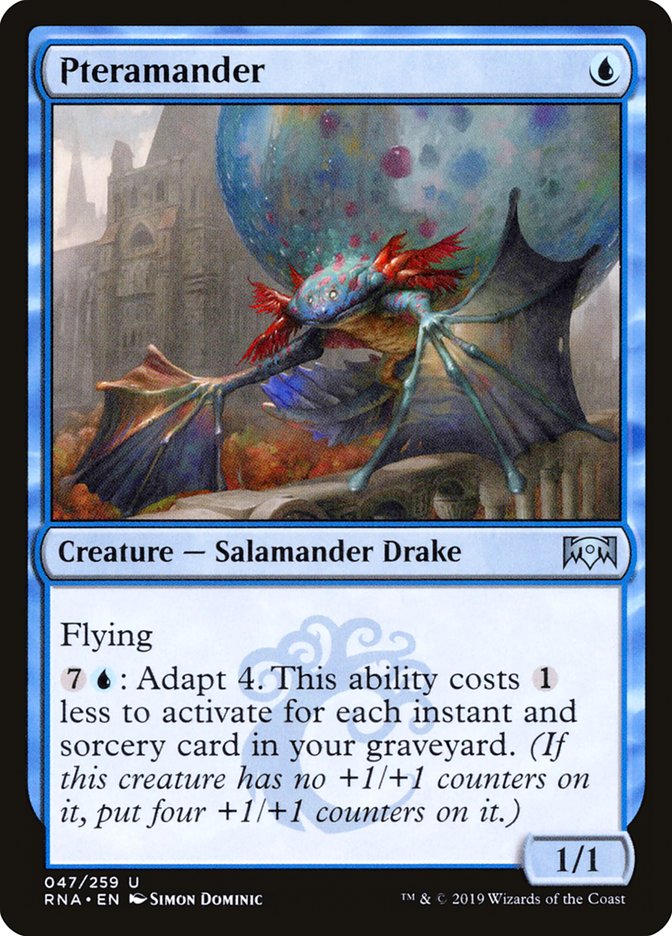It’s not easy for a set to make a large impact in Modern. With a cardpool
stretching across fifteen-and-a-half years, the bar for entry is high, and
there’s a reasonable fear that a card strong enough for Modern has the
potential to warp Standard around its existence. I’m happy to report that Ravnica Allegiance has solved this conundrum beautifully,
delivering a host of cards that are likely to give some serious tools to
Modern players across multitudinous archetypes. Even more impressively,
only one of my Top 5 Modern cards is going to appear in my Standard Top 10
list (to hear my Standard list, be sure to check out this week’s GAM
Podcast).
I think my list is somewhat bifurcated. Cards six through one seem like
surefire Modern players to me. These cards are easily slotting right in to
ready-made existing archetypes or are so powerful that they have the
capability to be build-arounds, even in the amped up world of Modern. Cards
ten through seven are a bit more speculative and either need some inspired
deckbuilding, future prints, or a specific metagame to find widespread
play. Without any further ado, on to my Top 10.
10. Cindervines
Cindervines is a strange card, one that doesn’t really fit with the general
paradigm of successful answer cards in Modern. For a card to become a
sideboard staple, it either needs to be the single most efficient version
of an effect (Nature’s Claim), have a particularly backbreaking impact on
the targeted deck (Stony Silence), or be so broad as to have an impact in
multiple matchups (Rakdos Charm). Cindervines is trying to gain a foothold
in the format by checking the last box and functioning as a targeted hate
card for artifacts and enchantments as well as storm-ish decks. The best of
the storm-ish decks is currently Ironworks, which obviously also packs
plenty of artifacts that you’re more than happy to keep off the
battlefield.
The problem is that even against a deck like Ironworks which is getting
dinged by both sides of Cindervines, the card seems unlikely to do enough
unless it’s accompanied by significant pressure. There are few decks in
Modern employing Gruul colors alongside aggression. The clearest home for
Cindervines is something like Burn that can make early life loss extremely
punishing. I could see Burn potentially employing copies of this card over
Destructive Revelry in spots where Ironworks has taken up tremendous
metagame share and Storm remains a concern. While Cindervines is not
game-breaking against Storm (double Grapeshot or Empty the Warrens hands
can beat Cindervines easily enough), it can potentially slow them down a
turn or two while sending four or five damage their way as they search for
an answer. It’s possible that more aggressive Jund builds could also
capitalize on early chip damage from Cindervines.
Ultimately, I think the artifact and enchantment removal side of
Cindervines is just too inefficient to acceptably fill that role in any
Modern deck. If there were a world where 25% of the field was on Ironworks
and Storm, and Storm had shifted back to Pyromancer Ascension, then maybe
it’d be time for Cindervines to shine. Since that’s not our present day,
Cindervines likely stays on the bench, but it’s a fine card to add to our
Modern binders in case things ever line up just right.
9. Rix Maadi Reveler
Modern decks and discard outlets… name a more iconic combination, I’ll
wait.
Efforts to discard Arclight Phoenix are currently all the rage in Modern.
While blue cantrips seem to be the way to go, it isn’t impossible to
imagine a world where access to spells like Terminate, Collective
Brutality, Thoughtseize, or even Death’s Shadow create a new way to give
someone the bird. Such a deck will surely be in the market for an
additional discard outlet that could refill a hand in the lategame.
While the glory days of Mardu Pyromancer are long gone, I wonder if a card
like Rix Maadi Reveler can gift the deck with enough flexibility in
deckbuilding to allow it to find success again. Previously, Bedlam Reveler
put some very hard restrictions on the number of non-instant and sorcery
spells your deck could contain. By making the switch to Rix Maadi Reveler,
you can include more Blood Moons, Lilianas, and impactful creatures.
This switch comes at a real cost, however, as Rix Maadi Reveler is not
quite as powerful a party goer as its Bedlam-loving compatriot. The highs
can never be quite as high as a two-mana Bedlam Reveler, and the spots
where you topdeck a Rix Maadi Reveler without the ability to deal any
damage will be exactly the wrong kind of spectacle. Is some deckbuilding
versatility and some increased resiliency to graveyard hate enough to make
Rix Maadi Reveler shine? I think its going to be a hard sell, but I’ve
certainly got a few shells Rix Maadi Reveler has me excited to try out.
8. Rhythm of the Wild
Rhythm of the Wild would probably never find a home in a Modern decklist if
it were being asked to play fair. Instead, Rhythm of the Wild will be asked
to empower a combination as old as the Modern format itself.

It’s pretty easy to come up with a host of reasons why Rhythm of the Wild
is worse than current enablers such as Melira, Anafenza, and Vizier of
Remedies. It can’t be found with Chord of Calling, Eldritch Evolution, or
Collected Company; it doesn’t contribute directly to your clock, and the
overlap that Vizier of Remedies has with the Devoted Druid combo is absent.
These are indisputable facts. However, haste and size buffs for all your
creatures are not irrelevant benefits. More importantly, Rhythm of the Wild
avoids some of the vulnerabilities of the cards above by virtue of being an
enchantment. Where is an opponent facing a battlefield of Kitchen Finks and
Rhythm of the Wild supposed to point their Lightning Bolt? Fewer
vulnerabilities to removal might earn persist combo decks some extra
points. In addition, the combo of Glen Elendra Archmage and Rhythm of the
Wild is kind of a wild new look. If only there were some other reason for
creature-based combo decks to start exploring blue splashes…
7.Prime Speaker Vannifar
I’ve loved seeing folks discover just how to go infinite with Prime Speaker
Vannifar and as few support pieces as possible. While I would love to live
in a world where I could get away with playing cards like Breeching
Hippocamp and Scyrb Ranger in my Modern Decks, I just don’t think these
setups are very realistic. Instead, I want to call back to the way Birthing
Pod decks used to be played – with a selection of some of the best value
creatures in the game and a combo that could potentially kill you out of
nowhere.
With Rhythm of the Wild and Prime Speaker Vannifar in your deck, I think
you can start to recapture some of that old magic. Finding whatever piece
is missing of a Devoted Druid/Vizier of Remedies combo, tutoring up the
Glen Elendra Archmage that will lock your opponent out of the game, or just
turning a Kitchen Finks into a more valuable situational replacement –
these are scenarios that seem much more Modern plausible than surviving to
the point where your Breaching Hippocamp finally gets to do something
meaningful.
It’s hard to say if someone is going to find just the right special sauce
to make Prime Speaker Vannifar hum, so I currently have it as the best of
my speculative Modern inclusions. Expect more on Prime Speaker Vannifar
from me in the future.
6. and 5. Judith, the Scourge Diva; and Hero of Precinct
One
I don’t think it’s any secret that Humans has found itself struggling as of
late. It’s not that the deck is inherently flawed; it’s just that it’s
currently interacting on the wrong axis. The more disruptive elements of
the deck, such as Kitesail Freebooter, are ineffectual weapons against the
best combo decks, and their clock is beginning to feel a bit too anemic.
Enter Judith and Hero of Precinct One. Offering Humans a greater ability to
go wide (and some additional reach once they get there) could be exactly
what Modern’s former top dog needs to rule the roost once more.
Perhaps only Judith makes the cut and simply looks to fill the Mantis Rider
slots. This would allow the deck to reignite its brief romance with
Collected Company, with a few more lords functioning as super impactful
Company hits. Whatever role these cards ultimately play in Humans, they’re
at least offering new options. Humans in its current configuration may be
on the verge of falling solidly into tier 2. Let’s see what Ravnica Allegiance has to say on the matter before we banish them
to sit with the also rans of the format.
4. Deputy of Detention
Speaking of Collected Company, it just found its new best friend. Reflector
Mage was already pushing into Bant Spirits builds, and Deputy of Detention
is a far more versatile card. Company decks gaining the ability to answer
multiple type of permanents (and multiple copies) at instant speed could
spell a resurgence for the non-tribal forms of Bant Company as well.
Modern continues to be a format where few decks occupy significant metagame
shares. You must be ready to answer everything from a Griselbrand to a
Training Grounds to an Amulet of Vigor. Bant Company decks were previously
extremely polarized builds that excelled in certain matchups and had
virtually no chance in others. Deputy of Detention is here to bring some
consistency to the archetype and is a creature that can bring its
controller back from some extremely difficult positions. Opponents better
hope they haven’t misused their Lightning Bolts…
3. Electrodominance
Hey, do you think casting any of the following cards in Modern might be a
strong play?

Every card that allows more methods of consistently casting Restore
Balance, Ancestral Vision, and Wheel of Fate scares the living daylights
out of me. As Foretold proved to be a miss, but
as previously pointed out by Emma Handy
, Electrodominance has a lot going on, including the ability to play some
of the most powerful Magic spells ever printed at instant speed.
Many other cards on the list are likely to be great Modern cards.
Electrodominance is the only one that has the possibility of someday
finding itself on the banned list. The only thing keeping this card from
the top of my list is the uncertainty that comes with trying to build a new
Modern archetype from the ground up. There are a lot of different problems
in Modern, and your deck must have some kind of solution to all of them.
Electrodominance pilots are still working to figure their problems out, but
when they do, they will be playing with power that belongs in Vintage.
2. Skewer the Critics
Over the past week, I’ve often felt like my head was going to explode while
people pumped out hyperbole, making statements like “Lightning Bolt is back
in Standard.” Skewer the Critics is so far from Lightning Bolt in Standard,
its laughable. Set up for spectacle is not guaranteed. Three mana is a ton to pay for your burn spell. And it’s a sorcery! Can we please
insert some reality back into the discussion? Lightning Bolt this is not.
Except in Modern Burn, where Skewer the Critics is basically Lightning
Bolt.
Obviously a significant step down from Lightning Bolt, but in the dedicated
Burn deck, it’s hard to create situations where you are punished for
playing Skewer the Critics. Either you’re forcing through some damage or
you have three mana available. Either situation means your opponent takes
three. Skewer the Critics is going to allow Modern Burn to have a greater
number of its most dominant openers. I think the power level of this card
is such that it instantly replaces any flex slot burn spells such as Shard
Volley, and I’m starting to believe that it may just be an upgrade on lower
end core spells like Rift Bolt. Burn is already starting to heat up in
Modern. With Skewer the Critics, it might be ready to set the world on
fire.
1. Pteramander
I honestly can’t believe this card is real. Pteramander is the new Delver
of Secrets, except it’s actually good in Modern. First, let’s talk about
the fail state of Pteramander. If your opponent has completely invalidated
your graveyard from the very start of the game, Pteramander is a 1/1 Ffyer
for one mana. While nothing to write home about, this dusts cards like the
two mana 0/1 Tarmogoyf, or the completely uncastable Bedlam Reveler. No
matter what your opponent does on turn 0, you’re deploying your 1/1 flyer
on turn 1.
Beyond this point, Pteramander rewards you for simply playing Magic. The
1/1 sits there, and at the first moment it makes strategic and logistical
sense to do so, you get to upgrade to what is basically the baddest beater
in the format. Shields don’t have to go down when you don’t want them too.
You don’t eat the entirety of your graveyard and prevent yourself from
playing additional copies on subsequent turns. You just have
mega-Pteramanders floating around your deck for the rest of the game.
Delver of Secrets was routinely outclassed and instilled too many
deckbuilding restrictions for too little reward. It was a horrible topdeck
in the lategame. Setup for lategame transformations was too inconsistent
without access to Brainstorm. Contrast this with Pteramander. It’s entirely
plausible to adapt Pteramander on Turn 3 simply by doing what your deck
will want to do. In the lategame, all your Pteramanders are 5/5 flyers for
UU.
The best deck in Modern is an Izzet deck which fuels its graveyard through
copious cantrip usage, leverages cheap or free spells, and minorly disrupts
an opponent until it can present a difficult to answer flying clock.
Pteramander is destined to slot into this deck. More exciting still are the
new archetypes Pteramander will spawn on its own. This is the blue card
that fundamentally alters the color’s capabilities in the Modern format.
Aggressive Thoughtseize decks are back on the menu. How about draw-go
Azorius Pteramander?
I personally can’t wait to explore Grixis Pteramander analogs to Legacy
Grixis Delver decks, where your Kolaghan’s Commands are returning two mana
flying 5/5s. This card is the future of Modern. Get ready.


